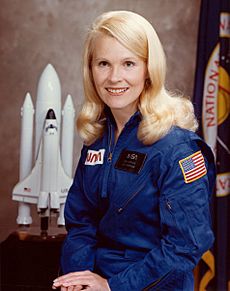Rhea Seddon facts for kids
Quick facts for kids
Rhea Seddon
|
|
|---|---|
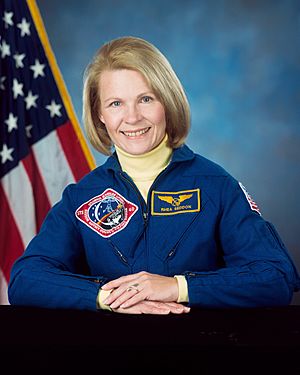
Seddon in 1992
|
|
| Born |
Margaret Rhea Seddon
November 8, 1947 Murfreesboro, Tennessee, U.S.
|
| Awards |
|
| Space career | |
| NASA astronaut | |
|
Time in space
|
30d 2h 21m |
| Selection | NASA Group 8 (1978) |
| Missions | STS-51-D STS-40 STS-58 |
|
Mission insignia
|
|
Margaret Rhea Seddon (born November 8, 1947) is an American surgeon and a former NASA astronaut. She was chosen as part of the first group of astronauts that included women in 1978.
Rhea Seddon flew on three Space Shuttle missions. She worked as a mission specialist on STS-51-D and STS-40. She was also a payload commander for STS-58. In total, she spent over 722 hours in space. During her missions, she helped create tools to fix a US Navy satellite and carried out important medical experiments.
She earned her medical degree (MD) in 1973 from the University of Tennessee, Memphis. During her training to become a surgeon, she was the only woman in her program. Before, during, and after her time as an astronaut, she worked in hospital emergency rooms in different states.
Seddon became an astronaut on August 9, 1979. At NASA, she helped develop software for the Space Shuttle and its payloads. She also worked on the Space Shuttle's medical kit and checklists for launch and landing. She was a rescue helicopter doctor for early Space Shuttle flights. She also worked as a capsule communicator (CAPCOM) in the Mission Control Center, talking to astronauts in space. In 1996, she helped prepare experiments for a space flight that studied the heart and blood vessels. She retired from NASA in November 1997.
Contents
Early Life and Education
Margaret Rhea Seddon was born in Murfreesboro, Tennessee, on November 8, 1947. She was the first child of Edward C. Seddon and Clayton Ransom Dann. She had a younger sister named Louise. Rhea was named after her grandmother and was known by her middle name, Rhea.
She grew up in Murfreesboro and went to St. Rose of Lima Catholic School. After the Sputnik crisis in 1957, science became a big focus in schools. Rhea started studying science in seventh grade. In 1960, she wrote a school report about what would happen to people in space. She graduated from Central High School in 1965.
A family friend, Lois Kennedy, was a doctor and inspired Rhea to become a doctor too. Another friend suggested universities in California with good science programs. Rhea went to the University of California, Berkeley. One summer, she worked in a hospital's surgical unit and decided she wanted to be a surgeon. She earned her degree in physiology in 1970.
In 1970, Rhea was accepted into the University of Tennessee College of Medicine. In her class of over one hundred medical students, only six were women. She received her medical degree (MD) in 1973. As a graduation gift, her father paid for flying lessons. She then completed her one-year internship and three years of residency in surgery. She was the only woman in the General Surgery Residency Program at the University of Tennessee hospitals. She also worked in emergency departments at several hospitals.
Becoming an Astronaut
How She Was Chosen
On July 8, 1976, National Aeronautics and Space Administration (NASA) asked people to apply to become pilots and mission specialists. This was the first time women were encouraged to apply. A friend told Rhea about the opportunity, and she decided to apply. She was just tall enough to meet the minimum height for mission specialists.
Out of 8,079 applicants, NASA chose 208 for more tests. Rhea was invited to the Johnson Space Center (JSC) for a week of interviews and medical exams. Her group of twenty applicants was the first to include women. In January 1978, she received official news that she had been selected for astronaut training. The names of the 35 successful candidates in NASA Astronaut Group 8 were announced later that day.
Astronaut Training
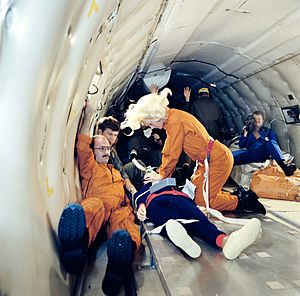
New astronauts were called "astronaut candidates" until they finished their two-year training. Mission specialist candidates did not need pilot training, but they learned how to handle emergencies in NASA's Northrop T-38 Talon jets. Rhea already had a private pilot license.
SCUBA diving training was a challenging part of the program for Rhea. She was not a strong swimmer and had to practice a lot. SCUBA training was needed for Extravehicular Activity (EVA) training, which is spacewalking. However, Rhea was never considered for spacewalks because NASA did not have space suits small enough for her.
In August 1979, Rhea officially became an astronaut. She was assigned to work on the Space Shuttle's food system and the medical kit used in orbit. For STS-1, the first Space Shuttle flight, Rhea and other doctors were assigned to search and rescue helicopters. These helicopters would be needed if the Space Shuttle had an emergency. The mission went well, so their help was not needed.
In February 1981, Rhea got engaged to fellow astronaut Robert L. "Hoot" Gibson. They married on May 30 in Murfreesboro. Rhea kept her maiden name. She continued her work with search and rescue for the STS-2 mission. She also worked in the Shuttle Avionics Integration Laboratory, testing the Space Shuttle's software.
Rhea's first child, Paul Seddon Gibson, was born in July 1982. This was the first child born to an astronaut couple.
Space Flights and Missions
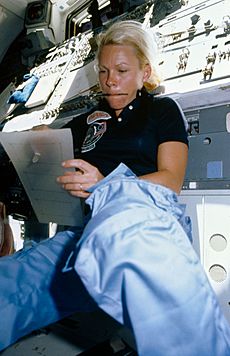
In August 1983, Rhea was assigned to her first space flight, STS-41-E. This mission was delayed and then canceled. The crew was then assigned to STS-51-E, which was also canceled. Finally, they were assigned to STS-51-D. Each time the mission changed, new training was needed for different payloads.
STS-51-D launched on April 12, 1985, aboard the Space Shuttle Discovery. The crew deployed two satellites. One of the satellites, Syncom IV-3, had a problem. This led to the first unplanned spacewalk and close-up operations for the Space Shuttle. Rhea used her surgical skills to help build homemade tools to fix the satellite. She used a bone saw to help create these tools. She tried to activate the satellite using the Remote Manipulator System (RMS), a robotic arm, but it did not work. The satellite was left in low Earth orbit. On this mission, she spent 168 hours in space.
After the flight, she met President Ronald Reagan in the Oval Office. The Syncom IV-3 satellite was later fixed and launched into its correct orbit by another mission.
Rhea was offered a chance to fly on the Spacelab Life Sciences (SLS-1) mission, scheduled for early 1986. This mission was delayed due to the Space Shuttle Challenger disaster. While waiting, she worked as an assistant to the Director of Flight Crew Operations. She helped set up rules for astronauts' medical records and how they were cleared to fly. She left this job when her second child, Edward Dann Gibson, was born in March 1989.
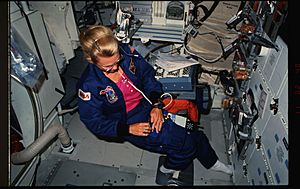
When Rhea returned from maternity leave in July 1989, the SLS-1 mission was scheduled as STS-40 for May 1990. The crew had been training for years, and the mission was very full of experiments. It was so busy that it was split into two missions: SLS-1 and SLS-2.
The STS-40 SLS-1 mission finally launched on June 5, 1991, aboard the Space Shuttle Columbia. During the nine-day mission, the crew performed experiments to see how humans, animals, and cells react to microgravity (very low gravity) and how they adjust back to Earth's gravity. They also studied materials science, plant biology, and cosmic radiation. The mission completed 146 orbits of Earth, and Rhea spent an additional 218 hours in space.
From September 1991 to July 1992, Rhea worked as a Capsule Communicator (CAPCOM) in the Mission Control Center. She talked to astronauts during the STS-42 and STS-45 missions. She wanted to be part of SLS-2, the follow-up mission to SLS-1. In October 1991, she was chosen as the payload commander for the STS-58 / SLS-2 mission. This was a new role to be the main contact for the science team. During training, she broke four bones in her foot during an emergency evacuation practice. She needed surgery, but she was still able to fly on the mission after it was delayed for other reasons.
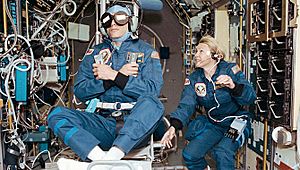
The SLS-2 mission involved studying animals, specifically rats, in space. NASA faced pressure from animal rights groups about these experiments. Rhea and payload specialist Martin J. Fettman prepared a report on how the research could be done. The mission went ahead as planned.
STS-58 with SLS-2 launched on October 18, 1993, aboard the Space Shuttle Columbia. During the fourteen-day flight, the seven-person crew performed many medical experiments on themselves and 48 rats. They studied how the body's balance system, heart, lungs, and muscles work in space. The mission completed 225 orbits of Earth and lasted over 336 hours.
In June 1995, Rhea had her third child, a daughter named Emilee Louise. Rhea then became the Assistant to the Director of Flight Crew Operations for Shuttle/Mir Payloads, which involved traveling to Russia. In September 1996, she was sent by NASA to Vanderbilt University Medical School in Nashville, Tennessee. She helped organize the medical group there and prepared experiments for another space flight in April 1998.
Later Life and Achievements
Rhea Seddon retired from NASA in November 1997. For the next eleven years, she was the assistant Chief Medical Officer of the Vanderbilt Medical Group in Nashville, Tennessee.
She started writing her life story in 1993. In 2008, she enrolled in a writing program to finish her book. Her book, called Go For Orbit, was published in 2015. It won an award for Best Autobiography/Memoir.
Awards and Honors
Rhea Seddon received several awards from NASA, including:
- The NASA Space Flight Medal in 1985, 1991, and 1993.
- The NASA Exceptional Service Medal in 1988 and 1992.
- The NASA Outstanding Leadership Medal in 1994.
She was honored in the Tennessee Aviation Hall of Fame in 2005. In 2015, she was inducted into both the United States Astronaut Hall of Fame and the Tennessee Women's Hall of Fame. In 2017, she was named one of the University of Tennessee's Top 100 Alumni. She also received the Great American leadership award with her husband, Robert Gibson.
See also
 In Spanish: Margaret Rhea Seddon para niños
In Spanish: Margaret Rhea Seddon para niños


